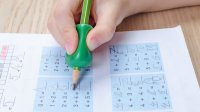Tips to Help Students With Their Handwriting
These simple tricks to improve motor skills can empower young learners to feel more in control of their handwriting.
Your content has been saved!
Go to My Saved Content.One of the most common referrals I’ve received as a school-based occupational therapist and evaluator over the past 13 years has been regarding difficulty with handwriting skills. Why is this?
One reason is that kids tend to be on the computer or other devices frequently. More and more digital options are available, including phones, video games, and other technology. This leads to less exposure connected to handwriting, pencil-to-paper tasks, crafts, and other related activities that build on underlying skills that lead to functional handwriting, including formation, sizing, spacing, and line regard, as well as overall speed.
Why students struggle with handwriting
There are many underlying skills that can impact handwriting legibility, including gross motor skills (whole body strength and coordination), fine motor skills (strength and coordination of the small muscles of the hands), attention (the ability to attend to and process specific information within the environment while filtering out the rest), sensory processing (how the brain processes and integrates information from the senses), and visual motor skills (the ability to translate a visual image/plan into an accurate motor action).
It’s important to remember the following before using the supports detailed later:
Your students may have a combination of underlying skill component difficulties affecting handwriting (i.e., sensory processing and fine motor skills), so you may want to have them complete supports for both of these difficulties before they work on writing tasks.
Provide your students with as much control over these activities as possible:
- Ask them what parts of the handwriting process feel difficult (don’t assume). This way you’ll be giving them control over building their skills.
- Have them choose from a selection of the specific supplies or tools they may need (e.g., a specific color of a grip).
- Introduce the strategies below when your students are calm and regulated.
These supports are best utilized beginning in kindergarten; if students within the preschool level express an interest in writing or most probably drawing, the strategies below can assist in developing underlying components connected to supporting their drawing and consequent handwriting skills
List of strategies divided by skill area
1. Gross motor: Footstool. This is any object placed under the student’s feet so that their feet aren’t dangling. A footstool can help students feel where their body is in space when they write, increasing related focus.
Use objects such as a crate, a cardboard box, or a large block as a footstool.
2. Visual motor: Eye scans. This exercise helps strengthen the eye muscles. This is important, as the eye muscles help students keep letters on the lines and maintain spaces between the words. Another word for this exercise is saccade, which is when the eyes move quickly from side to side. This is an important skill to use when students are reading, as well.
Directions:
- Have two frozen-pop sticks ready—-one with a smiley face and one with a check mark.
- Students should keep their head straight and only move their eyes.
- Have them look at the smiley face.
- Have them look at the check mark.
- Repeat five times.
3. Fine motor: Erasable pens. Erasable pens help students write in a smooth way and require less force to get the ink out than ordinary pens, making them a nice choice to use when students find it tricky to press hard enough on the paper or with “firm pressure.”
4. Attention: Visual timer. Have students set the timer for however long they expect that they can sit. A good estimate is one minute per year of life; so if a student is 8 years old, they should be able to sit for at least eight minutes and write. Knowing how long they’re expected to sit (especially when doing something challenging) can make it easier for them to focus.
5. Sensory processing: You can utilize a spiky pencil grip or a weighted pencil that will provide the students with tactile feedback.
- Spiky pencil grip: This provides great tactile/touch input for students who tend to touch items in their environment. Do you have students who press extra hard when they write? This type of pencil grip may help them press less hard, since they’re getting that touch input into their hands.
- Weighted pencil: This type of pencil gives students a proprioceptive awareness through added weight into the hand (giving them awareness of where their hand is in space). By placing the weight specifically near the tip, you're also allowing for optimal hand placement.
You can create your own weighted grip with two rubber bands and three hex nuts, as well as an optional foam grip for hand placement. (You could also add a variety of other grips that address grasp difficulties as well, such as the “the pencil grip,” “the crossover grip,” “the claw grip,” “the grotto grip,” etc.)
Put the pencil through the nuts so the nuts are in the middle of the pencil. Wrap one rubber band just before the three nuts and the other rubber band just after the three nuts; the rubber bands should hold the nuts in place. The child’s hand goes below the rubber band securing the nut nearest to the pencil tip (where you could also place a foam grip).
The above supports should help counterbalance time spent on the computer and enable young learners to strengthen the skills they need to feel secure in their handwriting.
